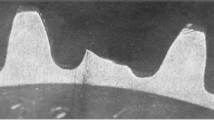Abstract
An analytical approach for determining case depth requirements in carburized gears is presented. It is indicated that the minimum case depth requirement in carburized gears is dictated primarily by spoiling fatigue which occurs when the applied alternating shear stress exceeds the allowable fatigue strength in the vicinity of the casecore boundary. Based on these concepts, the following procedure for establishing case depth is suggested: 1) From design load and gear geometry data, compute the applied shear stress gradient at the most severe location along the path of contact. 2) Transform applied shear stress gradient into a critical shear stress gradient using suitable design factors. 3) Convert the critical shear stress gradient into a hardness gradient by applying a torsional fatigue strength = UTS = hardness relationship. The validity of this approach has been substantiated by conducting constant torque four square dynamometer tests on several transmission gears carburized to varying case depths. By analyzing present production data and by applying basic hardenability principles, the stress/strength intersection concepts have been further used to demonstrate that current case depth requirements established on the basis of commonly used empirical rules may be over-specified.
Similar content being viewed by others
References
R. Pederson and R. L. Rice:Case Crushing of Carburized and Hardened Gears, Transactions of SAE 1961, p. 250.
D. Roempler:The Load Carrying Capacity of Bath Nitrided (Tufftrided) Gears, presented at the Semi-Annual Meeting of the AGMA, St. Louis, MO, Oct. 30–Nov. 2, 1966.
E. E. Shipley:Failure Modes in Gears, Gear Manufacture and Performance, American Society for Metals, Materials/Metalworking Technology Series, Metals Park, Ohio, 1974, p. 107.
ASM Committee on Failures of Gears:Failures of Gears, Failure Analysis and Prevention,ASM Metals Handbook, vol. 10, 1975, p. 507.
G. H. Robinson: “The Effect of Surface Condition on the Fatigue Resistance of Hardened Steel,”Fatigue Durability of Carburized Steel, published by ASM, 1957, p. 43.
A. I. Uludag: International Harvester Company, Neuss/Rhein Germany, Private communications.
H. R. Thomas and V. A. Hoersch:Stress Due to the Pressure of One Elastic Solid on Another, Bulletin of Engineering Experimental Station No. 212, University of Illinois, 1930.
F. B. Seely and J. O. Smith:Advanced Mechanics of Materials, Wiley, New York, 1959, p. 342.
J. O. Smith and C. K. Liu:J. Appl. Mech., June 1953, p. 157.
H. Fessier and E. Ollerton:Brit. J. Appl. Phys., vol. 8, July 1957, p. 387.
W. J. Greenert: Transactions of ASME,J. Basic Eng., vol. 84, 1962, p. 181.
J. A. Martin and A. D. Eberhardt: Transactions of ASME,J. Basic Eng., 1967, p. 932.
E. V. Zaretsky: Discussions to the paper by W. E. Littman,The Mechanism of Contact Fatigue, Proceedings Interdisciplinary Approach to the Lubrication of Concentrated Contacts—A NASA Symposium held RPI, Troy, N.Y., July 15–17, 1969.
C. Lipson and R. C. Juvinall:Handbook of Stress and Strength, McMillan Co., New York, 1963, p. 370.
J. M. Lessells:Strength and Resistance of Materials, Wiley, New York, 1954, p. 181.
R. Cazaud:Fatigue of Metals, Translated by A. J. Fenner, Philosophical Library, Inc., New York, 1953, p. 100.
J. O. Smith:The Effect of Range of Stress on the Fatigue Strength of Metals, University of Illinois Engineering Experimental Station Bulletin 334, 1942.
R. C. Juvinall:Engineering Considerations of Stress, Strain, and Strength, McGraw-Hill, New York, 1967, p. 274.
V. K. Sharma, G. H. Walter, and D. H. Breen:Stress and Strength Intersection Analysis to Optimize Cases in Carburized Gears, Technical Report System no. 76-40, ASM, Metals Park, Ohio.
G. H. Walter:Computer Oriented Gear Steel Design Procedure, presented at the Semi-Annual Meeting of the AGMA, Oak Brook, IL, Nov. 3–5, 1976.
D. H. Breen, G. H. Walter, and C. J. Keith:Metal Progress, April 1973, p. 105.
D. P. Koistinen:Trans. ASM, 1958, p. 277.
Author information
Authors and Affiliations
Rights and permissions
About this article
Cite this article
Sharma, V.K., Walter, G.H. & Breen, D.H. An analytical approach for establishing case depth requirements in carburized gears. J. Heat Treating 1, 48–57 (1979). https://doi.org/10.1007/BF02833209
Issue Date:
DOI: https://doi.org/10.1007/BF02833209




